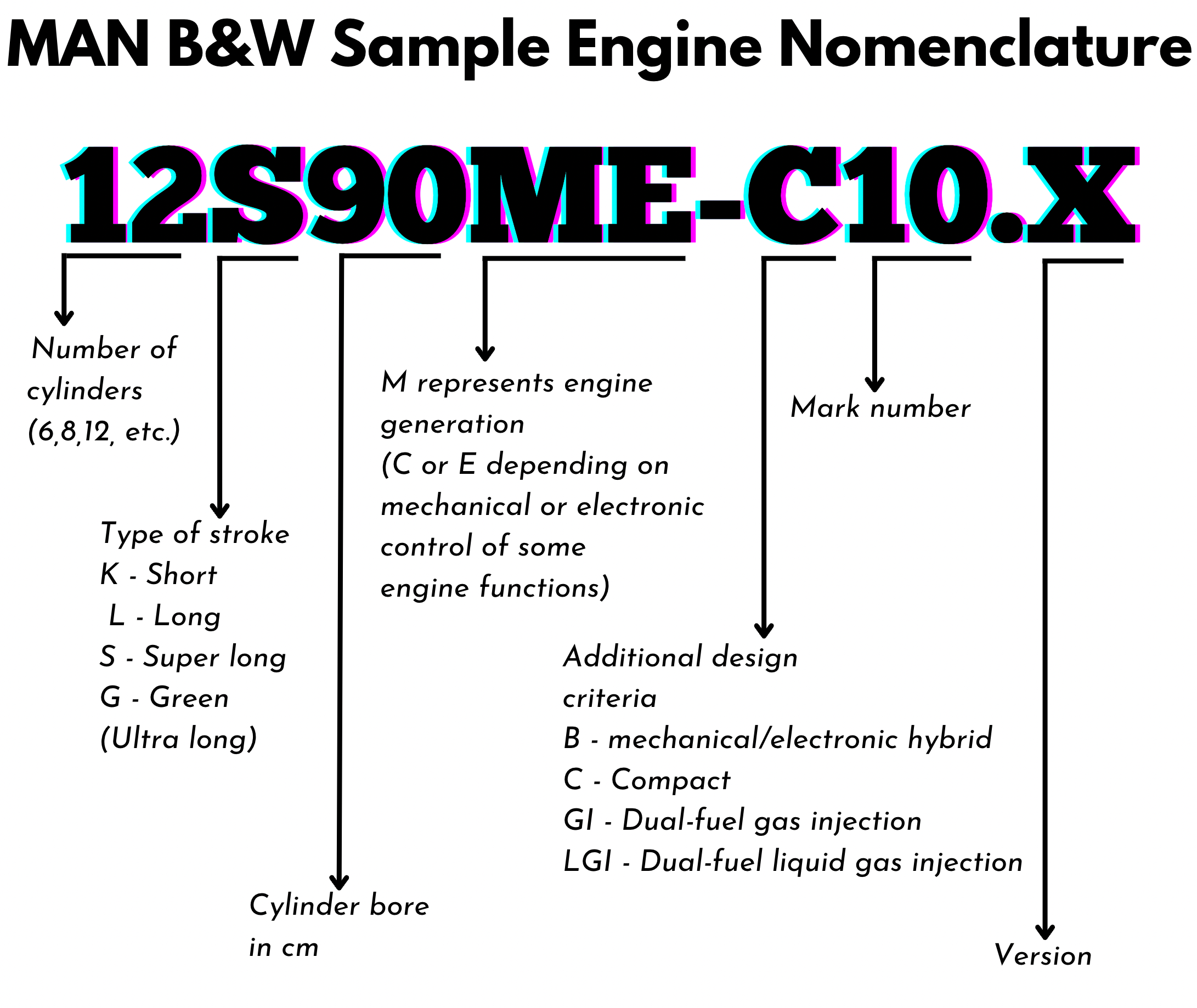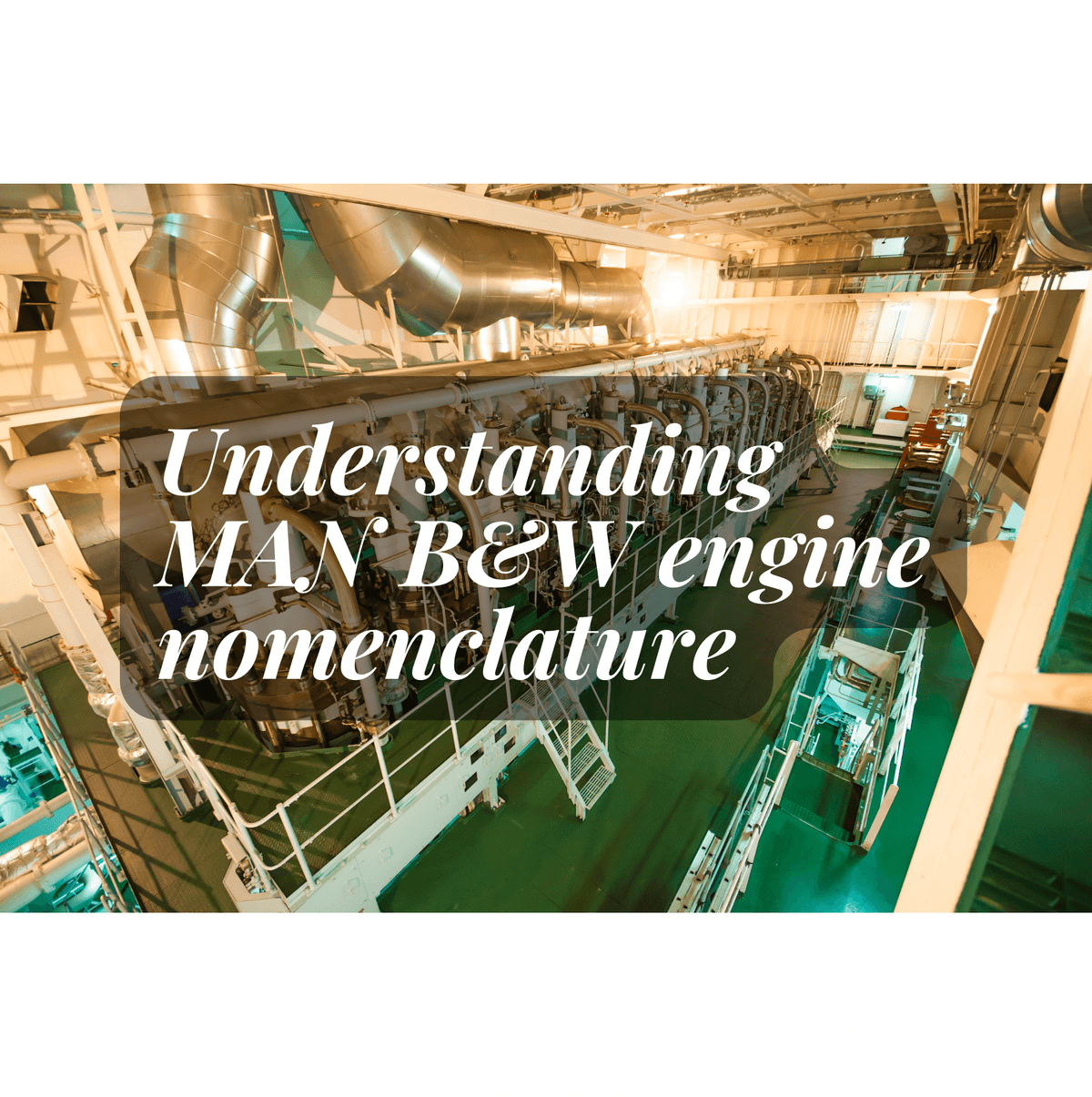Introduction
MAN B&W engine nomenclature can be difficult to understand and thus, difficult to recall. But once we are familiar with the concept behind it, we can understand crucial details about any engine within a fraction of a second.
And so, today, we shall attempt to understand the nomenclature rules behind MAN B&W’s marine diesel engines. By the end of this article, we will be able to understand the different types of engines by MAN B&W and how their nomenclature works.
Let us drive straight into it.
MAN B&W Engine Nomenclature
MAN (abbreviation of Maschinenfabrik Augsburg-Nürnberg) is one of the most popular names in the marine propulsion industry. Since it overtook the Burmeister and Wain shipyard and diesel engine producer, it has become popularly known as MAN B&W. Since then, MAN engines are branded as MAN B&W.
MAN’s beginnings in the industry go all the way back to the 18th century. Today, about 50,000 vessels are fitted with MAN engines. These engines power more than 50% of the world’s trade.
The company offers a wide range of two-stroke and four-stroke engines. In the two-stroke segment, engine capacities range from 1560 kW up to 82,440 kW.
Let us understand how MAN B&W prefers to name its engines.

The engine nomenclature in MAN B&W is pretty straightforward. The different parts of the nomenclature are explained ahead.
1. Number of cylinders
The first number in the engine name denotes the number of cylinders in the engine.
2. Type of stroke
The second letter denotes the type of stroke. From short to long, the letters used are K, L, S, and G. “Green” or ultra-long stroke is the latest addition to the MAN B&W engine portfolio. Traditionally, bulk carriers and tankers have preferred S-type engines because of their lower speeds and longer strokes.
On the other hand, containers have always preferred K-type (short-stroke) engines with their higher engine speeds. But as they have grown bigger in recent years, they are also preferring S-type engines.
As a result, MAN has introduced the G-series with an even longer stroke that allows the use of the lowest engine speeds and biggest propellers so far. These modifications afford additional fuel savings and CO2 reductions of up to 7%. Hence the name “Green”.
3. Bore size
The next number in the nomenclature gives the bore or diameter of the engine cylinders in cm.
All the above-mentioned series come in a variety of bore sizes. The range for MAN B&W two-stroke engines is between 30 to 95 cm.
4. Generation or program
The next letter in the engine nomenclature denotes the generation or program that the engine belongs to. In our case, the engine belongs to the ‘M’ generation.
5. Actuation mechanism
The next letter in the engine nomenclature denotes the type of system carrying out the actuation of parts such as exhaust valves, fuel pumps, etc.
Traditionally, engines depended on a camshaft that drew power from the main engine crankshaft. These were denoted with the letter ‘C’.
About 2 decades ago, in 2001, MAN B&W introduced electronically-actuated engines. These engines use an electrical actuation system for some of the functions that were previously carried out by a mechanical camshaft. A letter ‘E’ was added after the generation name (M in our case) to denote these engines.
As a result, these engines came to be known as ‘ME’ engines. ME engines were further of two types. Let us discuss that in the next section.
Related read: A Beginner’s Guide to Marine Engine Power and Efficiency Terminology
6. Additional design features
This letter gives further information about the engine design. It has several notations such as follows:
B – The term ‘B’ is used for mechanical/electronic hybrid control systems. In this engine, fuel injection is controlled electronically. This reduces the overall size of the main engine and offers advantages such as better fuel economy, lower propeller speeds, and lower lifecycle costs.
C – The letter ‘C’ stands for the word compact and is added after MC or ME engines to denote a compact structure. The ME-C engine is a more compact form of the ME-B engine.
Thus, these engines, compared to MC and ME-B engines require less space. In these engines, fuel injection and exhaust valve actuation have electronic control.
They also provide many other benefits such as a better power-to-weight ratio, simpler designs of key parts, and other benefits.
7. Additional details in the engine name
IMO has come up with criteria to classify marine engines based on their air pollution levels. These emissions standards are commonly known as Tier I to III standards.
They are added to an engine name to denote the standards that the engine adheres to. Thus, an engine name may be suffixed by TI, TII, or TIII to denote Tier I, II, or III respectively.
The details for this standard are shown in the table that follows:

Thus, if our sample engine adheres to Tier II, the complete engine name now becomes:
12S90ME-C10.X-TII
Exercise
Try to understand the specifications of the following actual MAN B&W Engines fitted on sailing vessels.
- 8s50MC-C
- 10K90MC-C5
- 9G95ME-C10.5
- 12K98ME-C7-TII
- 6S60ME-C8.2-TII
- 6G60ME-C9.5-TII
- 6G50ME-B9.3-LGI
- 12S90ME-C9.2-TII
- 11G90ME-C10.5-GI
- 7S50ME-C9.5-GI-TII

